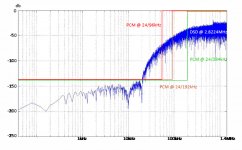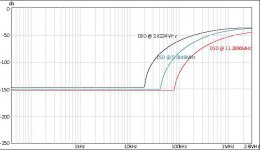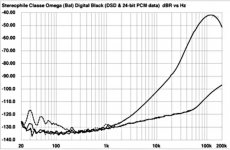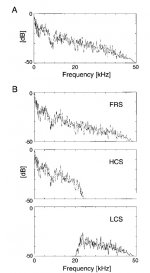I still have a Marantz CD-63SE that has survived a quarter of a century of light duty in a hostile environment (my kitchen).
A USB universal drive costs, what, $30 get up to date. Shove Apple where the sun don't shine (in either case, not that it matters). CD players will be here forever just like turntables and cartridges.
Just the kicking and screaming of the die hards. Who even wants to buy a USB CD/DVD drive add-on for their computer? Dont need it. Which is why my new computer does not come with it. Not needed. Mfr of those drives also disappearing. Who wants to bring their computer with them to play CD? Nay.
"Death of the Computer Optical Drive - Lifewire
Nov 14, 2019 - Why most modern PCs don't feature CD, DVD, or Blu-ray drives ... The flash memory used in these drives and in USB flash drives is what made ... rip music tracks to a format so they can listen to them on new media players.
"Do new laptops have DVD drives?
They're getting rarer every day, but there are also a few laptops on the market that still come with built-in DVD drives. ... All of the drives on these computers are capable of reading and writing both DVDs and CDs.Aug 15, 2019
Get your spare parts and extra drives before you cant get them any more.
-RNM
Last edited:
Who even wants to buy a USB CD/DVD drive add-on for their computer? Dont need it. Which is why my new computer does not come with it. Not needed. Mfr of those drives also disappearing. Who wants to bring their computer with them to play CD? Nay. Just the kicking and screaming of the die hards.
-RNM
Well, I happen to agree that 99% of people don't want it and don't care (nor do I).
I don't think the drives will completely disappear because BD-ROM is used in some data and archival applications still, along with tape. Flash memory has retention issues when it has not been powered on for a long time and it can be impossible to recover data in some cases with modern flash controllers. Someone will produce drives that can read a CD for at least the next 30 years. They still make 3.5" floppy drives.
I ripped all my audio CDs long ago and gave away the discs.
I ripped all my audio CDs long ago and gave away the discs.
🙂 😎
I have about 1000 CD to copy. 98% Blues. They take up a lot of space. I just throw them away after copying to mem. Nobody wants CD's.
-RNM
Last edited:
I still buy CD’s but the more I think about it, the more I’m attracted to the expense and inconvenience of vinyl.
What is the channel of communication or the method of applying those HF to the Brain?
It's still an interesting question.... 🙂
Oohashi et al. tried to examined it in a follow up study in 2006, compared the listener's response to earphone and loudspeaker reproduction. They found that listeners positive reactions only occured when listen to the loudspeaker reproduction.
The experimenters subsequently used cover masks for various parts (even whole body) and speculated that the main path could be bone conduction. (bone conduction is known to be able to do that, but looking at the transfer impedances makes one still wonder if it is the path)
Lenhardt (sorry not Lehnhardt) published an article in 2007 decribing another path that worked through the eyeballs.
Beside that, as that before, the positive results were mainly occuring in experiments using the original approach with gamelan music and it seems to be quite consistent, but the smaller number of experiments using other kind of music were inconclusive so it is still ......
I've never had the opportunity to listen to original indonesian gamelan music - bimo afair posted that he had - so can't comment.
Oohashi et al. ; The role of biological system other than auditory air-conduction in the emergence of the hypersonic effect; Brain Research 1073 - 1074, 2006, 339 - 347
Lenhardt, Martin L.; Eyes as Fenestrations to the Ears: A Novel Mechanism for High-Frequency and Ultrasonic Hearing; International Tinnitus Journal, Vol. 13, No. 1, 3–10 (2007)
I hate CDs. This cheap plastic box that refuses to open and whose hinge ends up breaking, the disc that is hard to extract, with this unpleasant impression that it is it who will break in two, and when you want to insert it in the drive if the player, it refuses to open with another CD stuck in it.
Ah, the good times of Vinyl and its wonderful covers, some real art works, and all the ceremonial before starting to play the magic, while you read the lyrics of pure poetry:
YouTube
Fellas, I'm ready to get up and do my thing
I wanna get into it, man, you know
Like a, like a sex machine, man,
Movin', doin' it, you know
Can I count it off? (Go ahead)
Get up, (get on up)
Get up, (get on up)
Stay on the scene, (get on up), like a sex machine, (get on up)
Get up, (get on up)
Get up, (get on up)
Stay on the scene, (get on up), like a sex machine, (get on up)
Get up, (get on up)
Stay on the scene, (get on up), like a sex machine, (get on up)
Wait a minute!
Shake your arm, then use your form
Stay on the scene like a sex machine
You got to have the feeling sure as you're born
Get it together, right on, right on
Get up, (get on up)
Get up, (get on up)
Get up, (get on up)
Hah!;-)
Ah, the good times of Vinyl and its wonderful covers, some real art works, and all the ceremonial before starting to play the magic, while you read the lyrics of pure poetry:
YouTube
Fellas, I'm ready to get up and do my thing
I wanna get into it, man, you know
Like a, like a sex machine, man,
Movin', doin' it, you know
Can I count it off? (Go ahead)
Get up, (get on up)
Get up, (get on up)
Stay on the scene, (get on up), like a sex machine, (get on up)
Get up, (get on up)
Get up, (get on up)
Stay on the scene, (get on up), like a sex machine, (get on up)
Get up, (get on up)
Stay on the scene, (get on up), like a sex machine, (get on up)
Wait a minute!
Shake your arm, then use your form
Stay on the scene like a sex machine
You got to have the feeling sure as you're born
Get it together, right on, right on
Get up, (get on up)
Get up, (get on up)
Get up, (get on up)
Hah!;-)
Last edited:
Got to laugh at people downloading high res music and playing it on a crappy phone, does not mean the world is getting any smarter, imo just more sheep in the line up, with nose firmly up the a$$ of the one in front of them.
Yes, many people have low-fi equipment. They can not tell the different of 44.1 or 96 cymbal recording, except PMA. Sadly, you are including.
It is strange for me, to see someone do not like high quality audio recording and do not like high quality audio product. And still follow audio forum 😀
I remember a member diyaudio who built many amplifiers but can not tell the sound different. Maybe he just enjoy to soldering.
Of course average people have lo-fi equipment. MP3 enough for them. It is nothing wrong, here. Just human nature. It is OK for rich people to buy the best product even they can not tell the different. But they are not mad when other people want lo-fi equipment.
I remember a member diyaudio who built many amplifiers but can not tell the sound different. Maybe he just enjoy to soldering.
Of course average people have lo-fi equipment. MP3 enough for them. It is nothing wrong, here. Just human nature. It is OK for rich people to buy the best product even they can not tell the different. But they are not mad when other people want lo-fi equipment.
Sounds like you have yet to master the removal technique and have a cheap player?I hate CDs. This cheap plastic box that refuses to open and whose hinge ends up breaking, the disc that is hard to extract, with this unpleasant impression that it is it who will break in two, and when you want to insert it in the drive if the player, it refuses to open with another CD stuck in it.
Yes, many people have low-fi equipment. They can not tell the different of 44.1 or 96 cymbal recording, except PMA...
I've previously reported that the difference between a MP3 and a 16/44 WAV is audible and annoying in all of the horrible car stereo's I've had over the years. The diff is also verifiable with some very lo-fi computer speakers. So it's not the $$$, it's the care and the tolerance to the garbage. I currently have a Fiio DAP playing 16/44 to 24/192 in my car, and it's tolerable for an hour or two, in spite of the stock amp that's probably class D.
...
I remember a member diyaudio who built many amplifiers but can not tell the sound different. Maybe he just enjoy to soldering...
Audio/electronics as a hoppy is perfectly legitimate. So times ago, I was searching for something and landed in a French forum, so I asked anyway, about some audio properties. The answer I got was: "Here, we solder. We don't care about the rest". 🙂
I've previously reported that the difference between a MP3 and a 16/44 WAV is audible and annoying in all of the horrible car stereo's I've had over the years.
As at the moment we mainly play Raffi in the car it really doesn't matter. I have 'are we there yet' in glorious surround sound as well.
My bet is that vinyl actually survives CD - talking physical media. 44,1 material will be around for a longlong time and there is a lot so playing them as good as absolutely possible is of importance. Higher rez is of course welcome as it should be and is an advantage. It promises a higher reproduction quality because it gives easier implementation aspects - but not for the reason of reproducing higher frequencies necessarily.
//
//
"a" ? Many of them, cheap or not.Sounds like you have yet to master the removal technique and have a cheap player?
I reported a long experience that I think we all have , including the CD/DVD transports in PCs and cars radios.
It is so frequent that all of them have, in their front a little hole to unlock the fragile mechanic of the drawer.
Yes T, I'm guessing your experience is a good representation of the majority of the 7.5 billion people on Earth 😉 I use a dedicated hi-fi music CD player to play my audio CDs through my hi-fi 🙂
You are obviously frustrated that you are almost alone in your opinion on the Oohashi experiment.It's still an interesting question.... 🙂
Oohashi et al. tried to examined it in a follow up study in 2006, compared the listener's response to earphone and loudspeaker reproduction. They found that listeners positive reactions only occured when listen to the loudspeaker reproduction.
The experimenters subsequently used cover masks for various parts (even whole body) and speculated that the main path could be bone conduction. (bone conduction is known to be able to do that, but looking at the transfer impedances makes one still wonder if it is the path)
Lenhardt (sorry not Lehnhardt) published an article in 2007 decribing another path that worked through the eyeballs.
Beside that, as that before, the positive results were mainly occuring in experiments using the original approach with gamelan music and it seems to be quite consistent, but the smaller number of experiments using other kind of music were inconclusive so it is still ......
I've never had the opportunity to listen to original indonesian gamelan music - bimo afair posted that he had - so can't comment.
Oohashi et al. ; The role of biological system other than auditory air-conduction in the emergence of the hypersonic effect; Brain Research 1073 - 1074, 2006, 339 - 347
Lenhardt, Martin L.; Eyes as Fenestrations to the Ears: A Novel Mechanism for High-Frequency and Ultrasonic Hearing; International Tinnitus Journal, Vol. 13, No. 1, 3–10 (2007)
Well, partly you were right that I didn't read the full report because when input is of dubious quality, the outcome of the experiment will have its flaw's also.
In other words, Rubish In - Rubish Out.
But to satisfy you, I have read two different Oohashi papers in concentration.
And I have to admit that they went to great length in interpreting EEG and Pet-Scans.
Had they spent just as much time at the input, the experiment would have gained quite a bit in trustworthiness.
Instead of just using words let me explain what I mean:
See image 1 below of a 2.8Mhz DSD noise spectrum, compared to various PCM formats.
DSD can only exist by the grace of aggressive noise shaping, shifting noise towards the HF part of the spectrum.
Second image shows the theoretical noise floor for several DSDformats,
To show how this works out in practice, image 3 shows the noise spectrum of a 2.8Mhz SACD with an added LPF at ca 100Khz, confirming the previous two spectra.
However Ooashi used 1.92 Mhz, causing his noise spectrum to shift even further to the left.
Conclusion is that with the used 1.92Mhz DSD, noise at 100Khz will be at around -40dB.
But looking at his Gamelan spectra, Image 4, I see no noise at 100Khz or below at all, how's that possible ?
That can only be when these spectra were made before digitizing and therefore do not represent the spectra as offered to the test candidates IMO.
Then following the text in his paper, "the recorded DSD signal was first presented to a D/A converter and then to resp LP- and HP-Filters with selectable 26Khz and 22Khz filters."
These filters have been analogue filters with 170dB ? and 80 dB/oct slopes. What was their FR and GD, not documented !!
He mentioned a flat response to 100Khz, but not where this was measured, at the output of the D/A or via a microphone at the position of the listener.
But in either case the FR of the filters and their GD is missing.
On top of that, FR from the speakers could very well be flat with both LPF and HPF in action, but that does not at all mean a flat response from both chains individually around crossover. That's why all these FR's and GD's are important.
And then my firm objection that when listening to the LPF version, the HPF chain was switched of and v.v.
This brings me back to the point that I have already mentioned a few times: when comparing things, reduce the amount of variables to the minimum.
Maybe he was too early, and 192/24 was not available at that time.
But when having used that format, there would have been no HF noise problem, and it would have simple to produce 3 versions. A master going to 100Khz, a LF 192/24 daughter brick wall and linear phase filtered to 20Khz and a brick wall filtered 192/24 daughter from 20Khz to 100Khz, also with a flat GD.
Playing these files over the same chain without switching Speakers on and off, would have resulted in a much more creditable experiment.
One speaker system, whether partly or complete active going to 100Khz should have been used all the time without any switching in between.
I'm alway in for new experience and more than willing to change my opinion, but only when proper attempts have been made for a sound test set up, which in this case I have called unscientific with unreliable outcome.
But chapeau for all the medical experiments, nice to see were hearing centra seem to be in our brains.
Hans




A few blocks down the road from my shop is a third generation machine shop specializing in springs. They made springs for the Victrola record players. You know the wind up kind. They still have the specialized tooling to make them. They still do runs of the springs for folks who are restoring them.
I have an old RCA broadcast 16" turntable that was modified to play other than 78s. It has two arms and can play outside to center and then back again as was the standard before tape recorders.
As to CDs... • Chart: The Rise and Fall of the Compact Disc | Statista
As to digital files... • Digital music revenue in the U.S. by type 2018 | Statista
Turns out folks prefer free music! Even so paid downloads are an order of magnitude more popular than physical media.
How much do you spend on internet service, cable TV or video discs?
Any takers for VHS tapes? Betamax!!!!???
I have an old RCA broadcast 16" turntable that was modified to play other than 78s. It has two arms and can play outside to center and then back again as was the standard before tape recorders.
As to CDs... • Chart: The Rise and Fall of the Compact Disc | Statista
As to digital files... • Digital music revenue in the U.S. by type 2018 | Statista
Turns out folks prefer free music! Even so paid downloads are an order of magnitude more popular than physical media.
How much do you spend on internet service, cable TV or video discs?
Any takers for VHS tapes? Betamax!!!!???
Last edited:
I have an old RCA broadcast 16" turntable that was modified to play other than 78s. It has two arms and can play outside to center and then back again as was the standard before tape recorders.
Any non auto record player can play from inside to out as well as outside in.
Any non auto record player can play from inside to out as well as outside in.
Most modern turntables have anti-skating compensation.
- Status
- Not open for further replies.
- Home
- Member Areas
- The Lounge
- John Curl's Blowtorch preamplifier part III